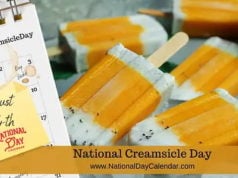
National Deviled Egg Day features a favorite hors-d’oeuvre or side dish for parties, holidays, family reunions, and potluck dinners. Deviled eggs are the star of the show each year on November 2nd.
- The first known print reference referring to the term “deviled” about food, appeared in 1786.
- It was in the 19th century that ‘deviled’ came to be used when referring to spicy or zesty food, including eggs prepared with mustard, pepper, or other ingredients stuffed in the yolk cavity.
- Deviled eggs are an ancient dish, with references to them first seen in recipes salvaged from Ancient Rome.
- The deviled egg originated in ancient Rome. Eggs were boiled, seasoned with spicy sauces, and then typically served at the beginning of a meal.
- Recipes for stuffed eggs began appearing in Andalusia, Spain in the 13th century, then across Europe throughout the 15th century. Stuffed egg recipes hit recipe books in the United States by the mid-19th century.
- The Oxford English Dictionary says, “The term ‘deviled egg’ was presumably adopted because of the association between the devil and the excessive heat in Hell.”
- A recipe from Fannie Farmer’s 1896 “Boston Cooking-School Cookbook” was one of the first to use mayonnaise as a binding agent for other ingredients. However, mayo wasn’t available commercially in the United States for another decade.
- In some circles in the U.S. and around the world, the eggs are known as “mimosa eggs,” “stuffed eggs,” “dressed eggs,” or “salad eggs,” — especially when served at church functions — to avoid the association with the devil.
- In France, the dish is called œuf mimosa (“mimosa egg”, named after the appearance of the mimosa tree); in Hungary, töltött tojás (“stuffed egg”) or kaszinótojás (“casino egg”); in Romania, ouă umplute (“stuffed eggs”); in Poland, jajka faszerowane (“stuffed eggs”); in the Netherlands gevuld ei (“stuffed egg”); in Sweden fyllda ägg (“stuffed eggs”); on the island of Malta bajd mimli (“stuffed eggs”). In parts of South America, it is called huevos a la peruana (“Peruvian eggs”).
- In many European countries, especially Belgium, France, the Netherlands and Germany, a variation is served known as “Russian eggs”. This consists of eggs cut in half, served with vegetable macédoine and garnished with mayonnaise, parsley and tomato. Contrary to what the name might suggest, the dish does not originate in Russia; its name derives from the fact that the eggs are served on a bed of macédoine, which is sometimes called “Russian salad“.
- In Sweden, the deviled egg (Fyllda Ägghalvor) is a traditional dish for the Easter Smörgåsbord, where the yolk is mixed with caviar, cream or sour cream, optionally chopped red onion, and decorated with chopped chives or dill, perhaps with a piece of anchovy or pickled herring.
- In French cuisine, the other ingredients are most likely to be pepper and parsley. In Hungarian cuisine, the yolks are mashed and mixed with white bread soaked in milk, mustard and parsley, often served as an appetizer with mayonnaise, or as a main course baked in the oven with Hungarian sour cream topping and served with French fries.
- Other common flavorings of the yolks in German cuisine are anchovy, cheese and caper.
- Deviled eggs are a common dish in the United States. In the Midwestern and Southern U.S., they are commonly served as hors d’oeuvres before a full meal is served, often during the Christmas season.
- Deviled eggs are so popular in the United States that special trays are sold specifically for serving them. Prepared and packaged deviled eggs are now available in some U.S. supermarkets.
- Deviled eggs are commonly served at Derby parties in Kentucky.
Sources:












